Case Study Analysis: Family Therapy and Socioeconomic Factors
VerifiedAdded on 2021/11/11
|8
|1759
|55
Report
AI Summary
This report analyzes a family therapy case study involving a family struggling with socioeconomic challenges after migrating to Melbourne. The analysis explores the impact of ethnicity (Greek father, Aboriginal mother), class (financial struggles), and gender (traditional gender roles) on family dynamics. The report identifies the family's strengths, including support from school representatives and the HLSO department, and proposes engagement and assessment plans. It highlights the importance of detailed information in therapy assessments, pointing out missing data such as reasons for the children's absences, the mother's nervousness, and the family's marital status. The author reflects on how personal experiences, such as poverty and cultural differences, informed the assessment, emphasizing the power dynamics within the family and lessons learned about cultural impact and the challenges faced by therapists. The report concludes with a list of relevant references.
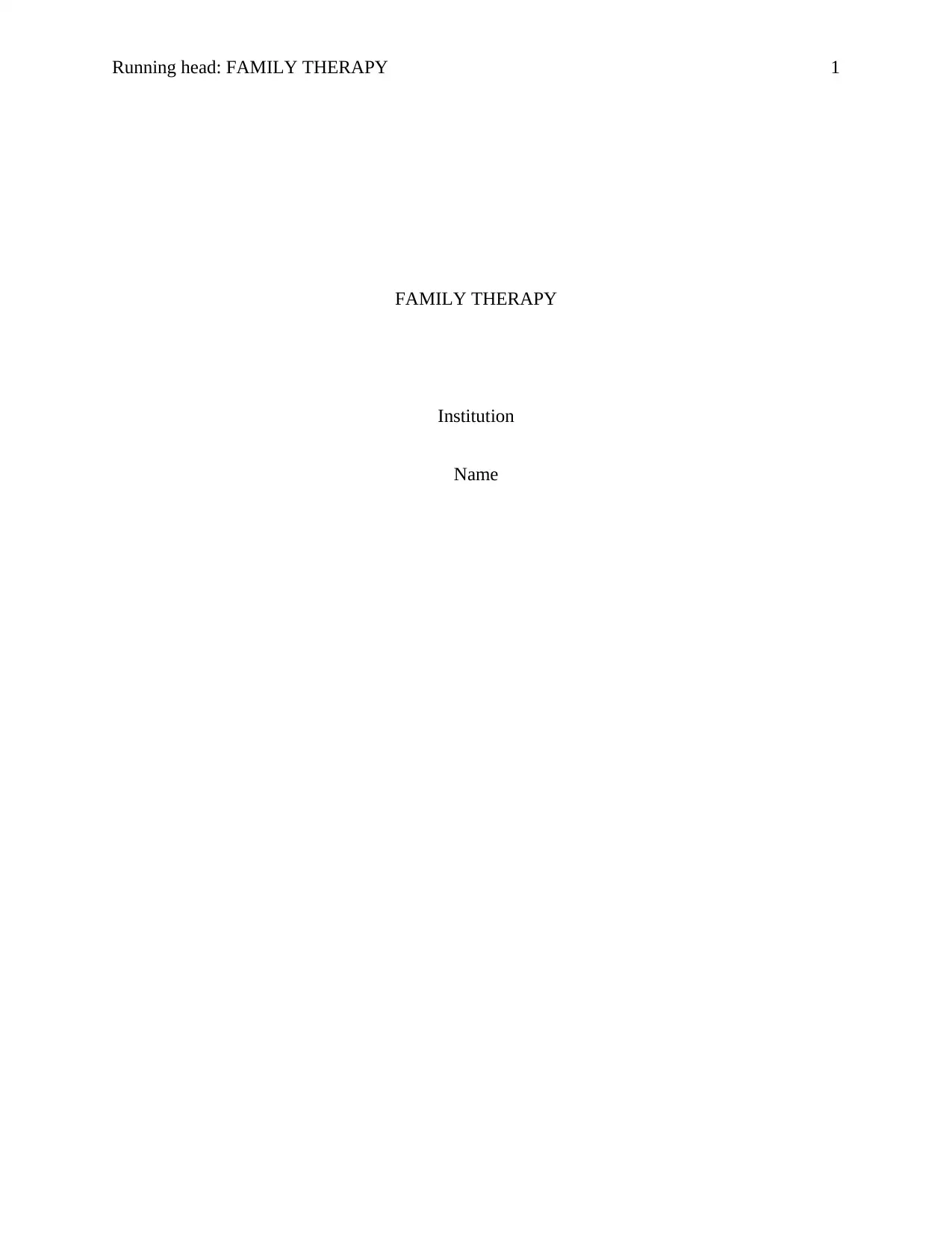
Running head: FAMILY THERAPY 1
FAMILY THERAPY
Institution
Name
FAMILY THERAPY
Institution
Name
Paraphrase This Document
Need a fresh take? Get an instant paraphrase of this document with our AI Paraphraser
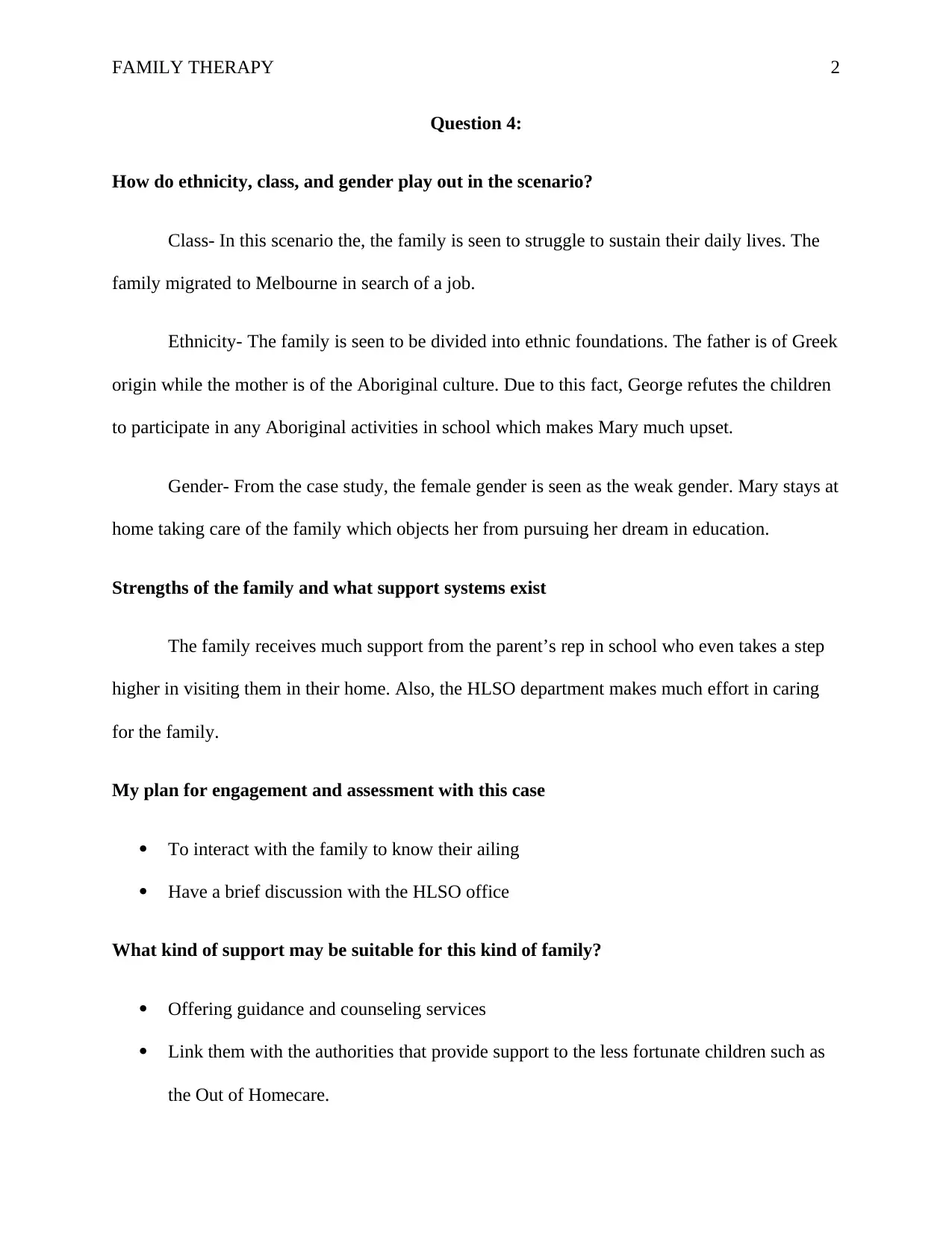
FAMILY THERAPY 2
Question 4:
How do ethnicity, class, and gender play out in the scenario?
Class- In this scenario the, the family is seen to struggle to sustain their daily lives. The
family migrated to Melbourne in search of a job.
Ethnicity- The family is seen to be divided into ethnic foundations. The father is of Greek
origin while the mother is of the Aboriginal culture. Due to this fact, George refutes the children
to participate in any Aboriginal activities in school which makes Mary much upset.
Gender- From the case study, the female gender is seen as the weak gender. Mary stays at
home taking care of the family which objects her from pursuing her dream in education.
Strengths of the family and what support systems exist
The family receives much support from the parent’s rep in school who even takes a step
higher in visiting them in their home. Also, the HLSO department makes much effort in caring
for the family.
My plan for engagement and assessment with this case
To interact with the family to know their ailing
Have a brief discussion with the HLSO office
What kind of support may be suitable for this kind of family?
Offering guidance and counseling services
Link them with the authorities that provide support to the less fortunate children such as
the Out of Homecare.
Question 4:
How do ethnicity, class, and gender play out in the scenario?
Class- In this scenario the, the family is seen to struggle to sustain their daily lives. The
family migrated to Melbourne in search of a job.
Ethnicity- The family is seen to be divided into ethnic foundations. The father is of Greek
origin while the mother is of the Aboriginal culture. Due to this fact, George refutes the children
to participate in any Aboriginal activities in school which makes Mary much upset.
Gender- From the case study, the female gender is seen as the weak gender. Mary stays at
home taking care of the family which objects her from pursuing her dream in education.
Strengths of the family and what support systems exist
The family receives much support from the parent’s rep in school who even takes a step
higher in visiting them in their home. Also, the HLSO department makes much effort in caring
for the family.
My plan for engagement and assessment with this case
To interact with the family to know their ailing
Have a brief discussion with the HLSO office
What kind of support may be suitable for this kind of family?
Offering guidance and counseling services
Link them with the authorities that provide support to the less fortunate children such as
the Out of Homecare.
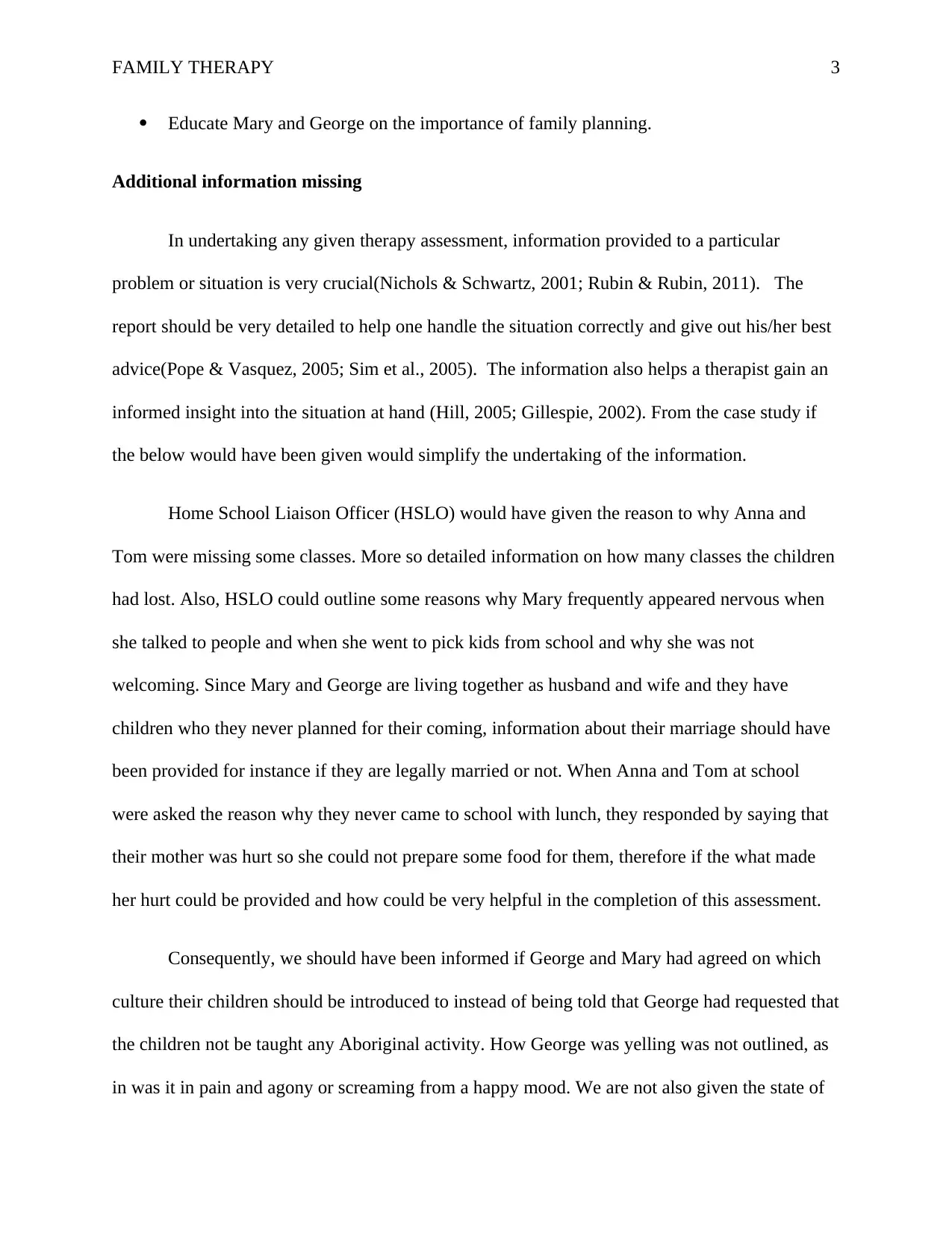
FAMILY THERAPY 3
Educate Mary and George on the importance of family planning.
Additional information missing
In undertaking any given therapy assessment, information provided to a particular
problem or situation is very crucial(Nichols & Schwartz, 2001; Rubin & Rubin, 2011). The
report should be very detailed to help one handle the situation correctly and give out his/her best
advice(Pope & Vasquez, 2005; Sim et al., 2005). The information also helps a therapist gain an
informed insight into the situation at hand (Hill, 2005; Gillespie, 2002). From the case study if
the below would have been given would simplify the undertaking of the information.
Home School Liaison Officer (HSLO) would have given the reason to why Anna and
Tom were missing some classes. More so detailed information on how many classes the children
had lost. Also, HSLO could outline some reasons why Mary frequently appeared nervous when
she talked to people and when she went to pick kids from school and why she was not
welcoming. Since Mary and George are living together as husband and wife and they have
children who they never planned for their coming, information about their marriage should have
been provided for instance if they are legally married or not. When Anna and Tom at school
were asked the reason why they never came to school with lunch, they responded by saying that
their mother was hurt so she could not prepare some food for them, therefore if the what made
her hurt could be provided and how could be very helpful in the completion of this assessment.
Consequently, we should have been informed if George and Mary had agreed on which
culture their children should be introduced to instead of being told that George had requested that
the children not be taught any Aboriginal activity. How George was yelling was not outlined, as
in was it in pain and agony or screaming from a happy mood. We are not also given the state of
Educate Mary and George on the importance of family planning.
Additional information missing
In undertaking any given therapy assessment, information provided to a particular
problem or situation is very crucial(Nichols & Schwartz, 2001; Rubin & Rubin, 2011). The
report should be very detailed to help one handle the situation correctly and give out his/her best
advice(Pope & Vasquez, 2005; Sim et al., 2005). The information also helps a therapist gain an
informed insight into the situation at hand (Hill, 2005; Gillespie, 2002). From the case study if
the below would have been given would simplify the undertaking of the information.
Home School Liaison Officer (HSLO) would have given the reason to why Anna and
Tom were missing some classes. More so detailed information on how many classes the children
had lost. Also, HSLO could outline some reasons why Mary frequently appeared nervous when
she talked to people and when she went to pick kids from school and why she was not
welcoming. Since Mary and George are living together as husband and wife and they have
children who they never planned for their coming, information about their marriage should have
been provided for instance if they are legally married or not. When Anna and Tom at school
were asked the reason why they never came to school with lunch, they responded by saying that
their mother was hurt so she could not prepare some food for them, therefore if the what made
her hurt could be provided and how could be very helpful in the completion of this assessment.
Consequently, we should have been informed if George and Mary had agreed on which
culture their children should be introduced to instead of being told that George had requested that
the children not be taught any Aboriginal activity. How George was yelling was not outlined, as
in was it in pain and agony or screaming from a happy mood. We are not also given the state of
⊘ This is a preview!⊘
Do you want full access?
Subscribe today to unlock all pages.

Trusted by 1+ million students worldwide
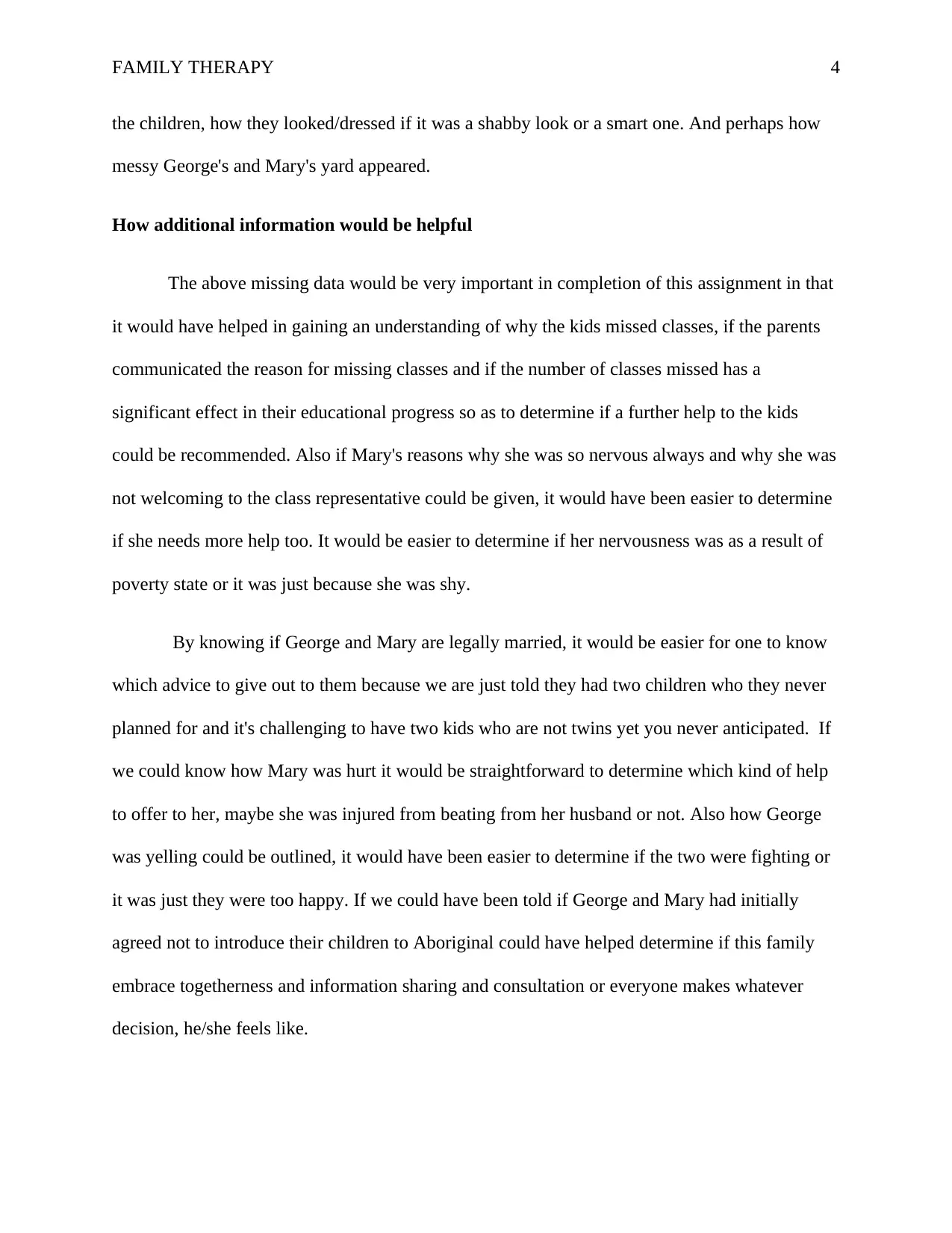
FAMILY THERAPY 4
the children, how they looked/dressed if it was a shabby look or a smart one. And perhaps how
messy George's and Mary's yard appeared.
How additional information would be helpful
The above missing data would be very important in completion of this assignment in that
it would have helped in gaining an understanding of why the kids missed classes, if the parents
communicated the reason for missing classes and if the number of classes missed has a
significant effect in their educational progress so as to determine if a further help to the kids
could be recommended. Also if Mary's reasons why she was so nervous always and why she was
not welcoming to the class representative could be given, it would have been easier to determine
if she needs more help too. It would be easier to determine if her nervousness was as a result of
poverty state or it was just because she was shy.
By knowing if George and Mary are legally married, it would be easier for one to know
which advice to give out to them because we are just told they had two children who they never
planned for and it's challenging to have two kids who are not twins yet you never anticipated. If
we could know how Mary was hurt it would be straightforward to determine which kind of help
to offer to her, maybe she was injured from beating from her husband or not. Also how George
was yelling could be outlined, it would have been easier to determine if the two were fighting or
it was just they were too happy. If we could have been told if George and Mary had initially
agreed not to introduce their children to Aboriginal could have helped determine if this family
embrace togetherness and information sharing and consultation or everyone makes whatever
decision, he/she feels like.
the children, how they looked/dressed if it was a shabby look or a smart one. And perhaps how
messy George's and Mary's yard appeared.
How additional information would be helpful
The above missing data would be very important in completion of this assignment in that
it would have helped in gaining an understanding of why the kids missed classes, if the parents
communicated the reason for missing classes and if the number of classes missed has a
significant effect in their educational progress so as to determine if a further help to the kids
could be recommended. Also if Mary's reasons why she was so nervous always and why she was
not welcoming to the class representative could be given, it would have been easier to determine
if she needs more help too. It would be easier to determine if her nervousness was as a result of
poverty state or it was just because she was shy.
By knowing if George and Mary are legally married, it would be easier for one to know
which advice to give out to them because we are just told they had two children who they never
planned for and it's challenging to have two kids who are not twins yet you never anticipated. If
we could know how Mary was hurt it would be straightforward to determine which kind of help
to offer to her, maybe she was injured from beating from her husband or not. Also how George
was yelling could be outlined, it would have been easier to determine if the two were fighting or
it was just they were too happy. If we could have been told if George and Mary had initially
agreed not to introduce their children to Aboriginal could have helped determine if this family
embrace togetherness and information sharing and consultation or everyone makes whatever
decision, he/she feels like.
Paraphrase This Document
Need a fresh take? Get an instant paraphrase of this document with our AI Paraphraser
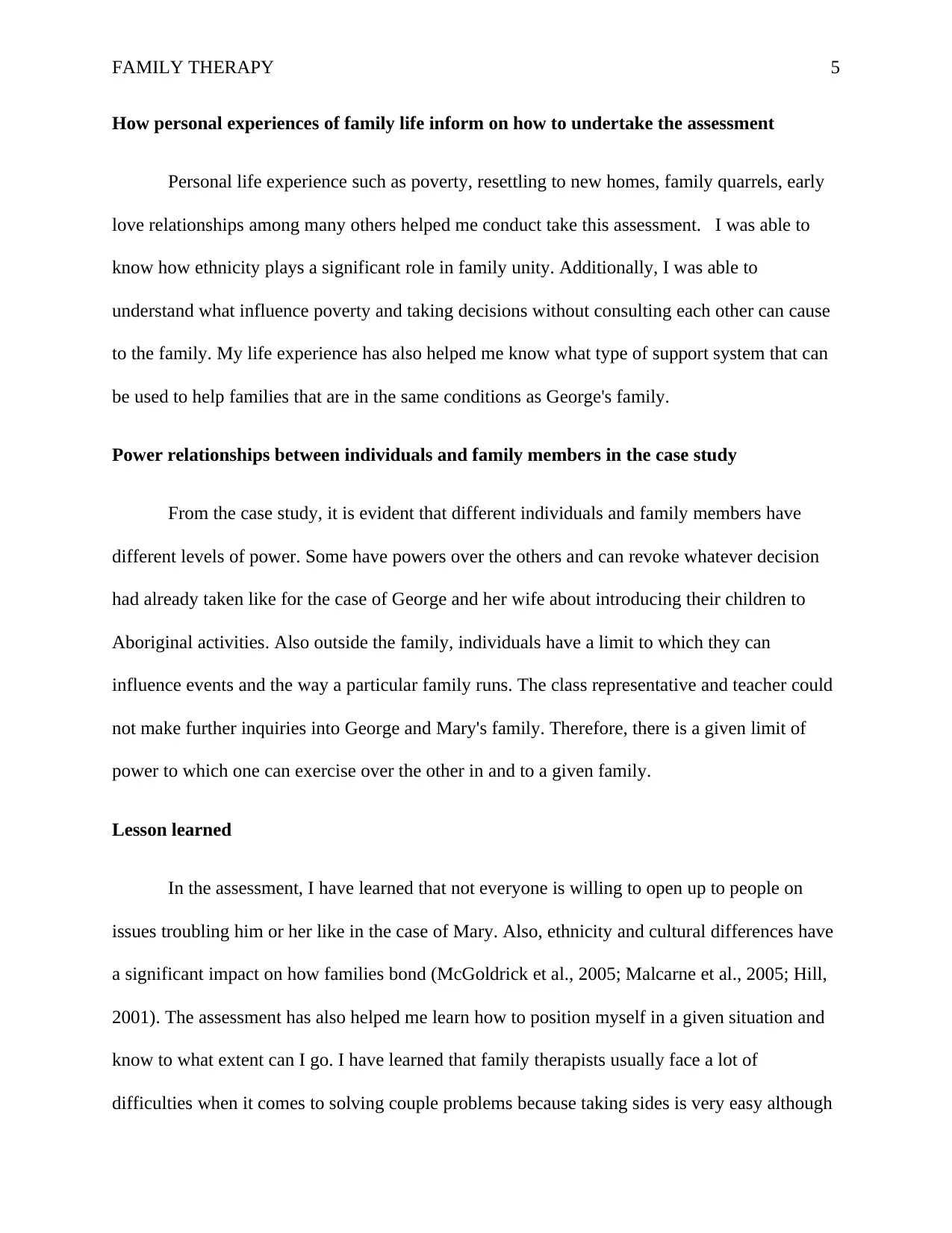
FAMILY THERAPY 5
How personal experiences of family life inform on how to undertake the assessment
Personal life experience such as poverty, resettling to new homes, family quarrels, early
love relationships among many others helped me conduct take this assessment. I was able to
know how ethnicity plays a significant role in family unity. Additionally, I was able to
understand what influence poverty and taking decisions without consulting each other can cause
to the family. My life experience has also helped me know what type of support system that can
be used to help families that are in the same conditions as George's family.
Power relationships between individuals and family members in the case study
From the case study, it is evident that different individuals and family members have
different levels of power. Some have powers over the others and can revoke whatever decision
had already taken like for the case of George and her wife about introducing their children to
Aboriginal activities. Also outside the family, individuals have a limit to which they can
influence events and the way a particular family runs. The class representative and teacher could
not make further inquiries into George and Mary's family. Therefore, there is a given limit of
power to which one can exercise over the other in and to a given family.
Lesson learned
In the assessment, I have learned that not everyone is willing to open up to people on
issues troubling him or her like in the case of Mary. Also, ethnicity and cultural differences have
a significant impact on how families bond (McGoldrick et al., 2005; Malcarne et al., 2005; Hill,
2001). The assessment has also helped me learn how to position myself in a given situation and
know to what extent can I go. I have learned that family therapists usually face a lot of
difficulties when it comes to solving couple problems because taking sides is very easy although
How personal experiences of family life inform on how to undertake the assessment
Personal life experience such as poverty, resettling to new homes, family quarrels, early
love relationships among many others helped me conduct take this assessment. I was able to
know how ethnicity plays a significant role in family unity. Additionally, I was able to
understand what influence poverty and taking decisions without consulting each other can cause
to the family. My life experience has also helped me know what type of support system that can
be used to help families that are in the same conditions as George's family.
Power relationships between individuals and family members in the case study
From the case study, it is evident that different individuals and family members have
different levels of power. Some have powers over the others and can revoke whatever decision
had already taken like for the case of George and her wife about introducing their children to
Aboriginal activities. Also outside the family, individuals have a limit to which they can
influence events and the way a particular family runs. The class representative and teacher could
not make further inquiries into George and Mary's family. Therefore, there is a given limit of
power to which one can exercise over the other in and to a given family.
Lesson learned
In the assessment, I have learned that not everyone is willing to open up to people on
issues troubling him or her like in the case of Mary. Also, ethnicity and cultural differences have
a significant impact on how families bond (McGoldrick et al., 2005; Malcarne et al., 2005; Hill,
2001). The assessment has also helped me learn how to position myself in a given situation and
know to what extent can I go. I have learned that family therapists usually face a lot of
difficulties when it comes to solving couple problems because taking sides is very easy although
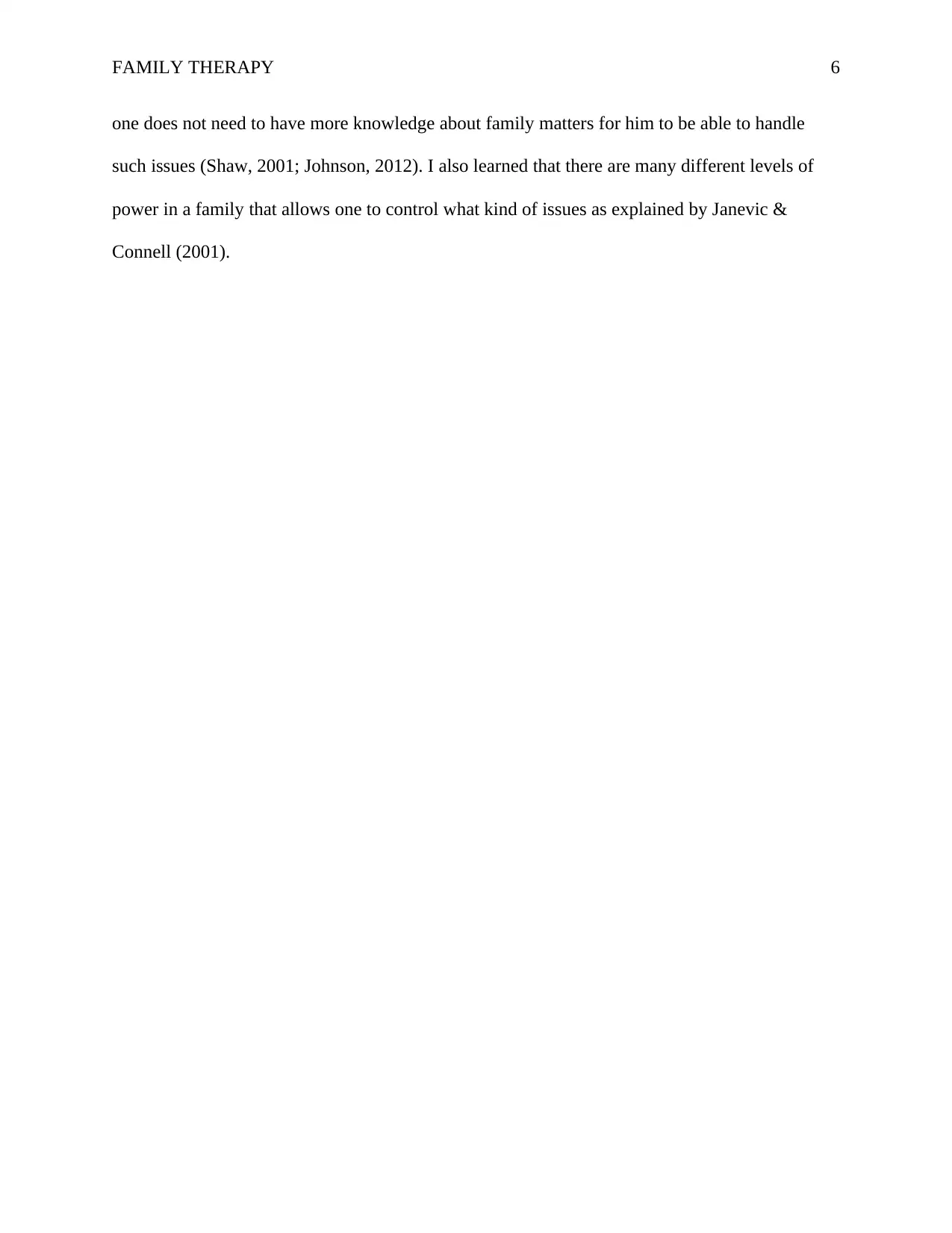
FAMILY THERAPY 6
one does not need to have more knowledge about family matters for him to be able to handle
such issues (Shaw, 2001; Johnson, 2012). I also learned that there are many different levels of
power in a family that allows one to control what kind of issues as explained by Janevic &
Connell (2001).
one does not need to have more knowledge about family matters for him to be able to handle
such issues (Shaw, 2001; Johnson, 2012). I also learned that there are many different levels of
power in a family that allows one to control what kind of issues as explained by Janevic &
Connell (2001).
⊘ This is a preview!⊘
Do you want full access?
Subscribe today to unlock all pages.

Trusted by 1+ million students worldwide
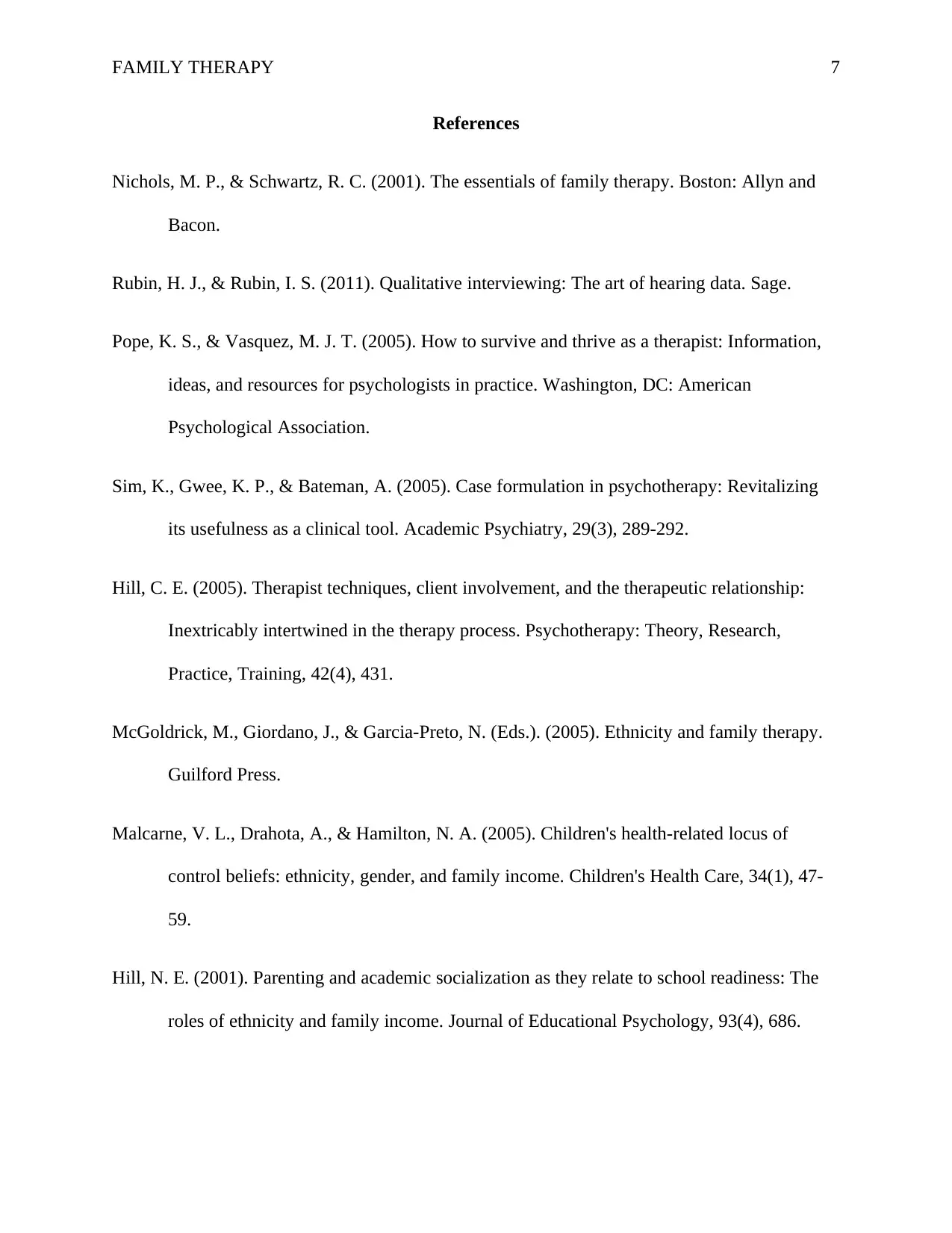
FAMILY THERAPY 7
References
Nichols, M. P., & Schwartz, R. C. (2001). The essentials of family therapy. Boston: Allyn and
Bacon.
Rubin, H. J., & Rubin, I. S. (2011). Qualitative interviewing: The art of hearing data. Sage.
Pope, K. S., & Vasquez, M. J. T. (2005). How to survive and thrive as a therapist: Information,
ideas, and resources for psychologists in practice. Washington, DC: American
Psychological Association.
Sim, K., Gwee, K. P., & Bateman, A. (2005). Case formulation in psychotherapy: Revitalizing
its usefulness as a clinical tool. Academic Psychiatry, 29(3), 289-292.
Hill, C. E. (2005). Therapist techniques, client involvement, and the therapeutic relationship:
Inextricably intertwined in the therapy process. Psychotherapy: Theory, Research,
Practice, Training, 42(4), 431.
McGoldrick, M., Giordano, J., & Garcia-Preto, N. (Eds.). (2005). Ethnicity and family therapy.
Guilford Press.
Malcarne, V. L., Drahota, A., & Hamilton, N. A. (2005). Children's health-related locus of
control beliefs: ethnicity, gender, and family income. Children's Health Care, 34(1), 47-
59.
Hill, N. E. (2001). Parenting and academic socialization as they relate to school readiness: The
roles of ethnicity and family income. Journal of Educational Psychology, 93(4), 686.
References
Nichols, M. P., & Schwartz, R. C. (2001). The essentials of family therapy. Boston: Allyn and
Bacon.
Rubin, H. J., & Rubin, I. S. (2011). Qualitative interviewing: The art of hearing data. Sage.
Pope, K. S., & Vasquez, M. J. T. (2005). How to survive and thrive as a therapist: Information,
ideas, and resources for psychologists in practice. Washington, DC: American
Psychological Association.
Sim, K., Gwee, K. P., & Bateman, A. (2005). Case formulation in psychotherapy: Revitalizing
its usefulness as a clinical tool. Academic Psychiatry, 29(3), 289-292.
Hill, C. E. (2005). Therapist techniques, client involvement, and the therapeutic relationship:
Inextricably intertwined in the therapy process. Psychotherapy: Theory, Research,
Practice, Training, 42(4), 431.
McGoldrick, M., Giordano, J., & Garcia-Preto, N. (Eds.). (2005). Ethnicity and family therapy.
Guilford Press.
Malcarne, V. L., Drahota, A., & Hamilton, N. A. (2005). Children's health-related locus of
control beliefs: ethnicity, gender, and family income. Children's Health Care, 34(1), 47-
59.
Hill, N. E. (2001). Parenting and academic socialization as they relate to school readiness: The
roles of ethnicity and family income. Journal of Educational Psychology, 93(4), 686.
Paraphrase This Document
Need a fresh take? Get an instant paraphrase of this document with our AI Paraphraser
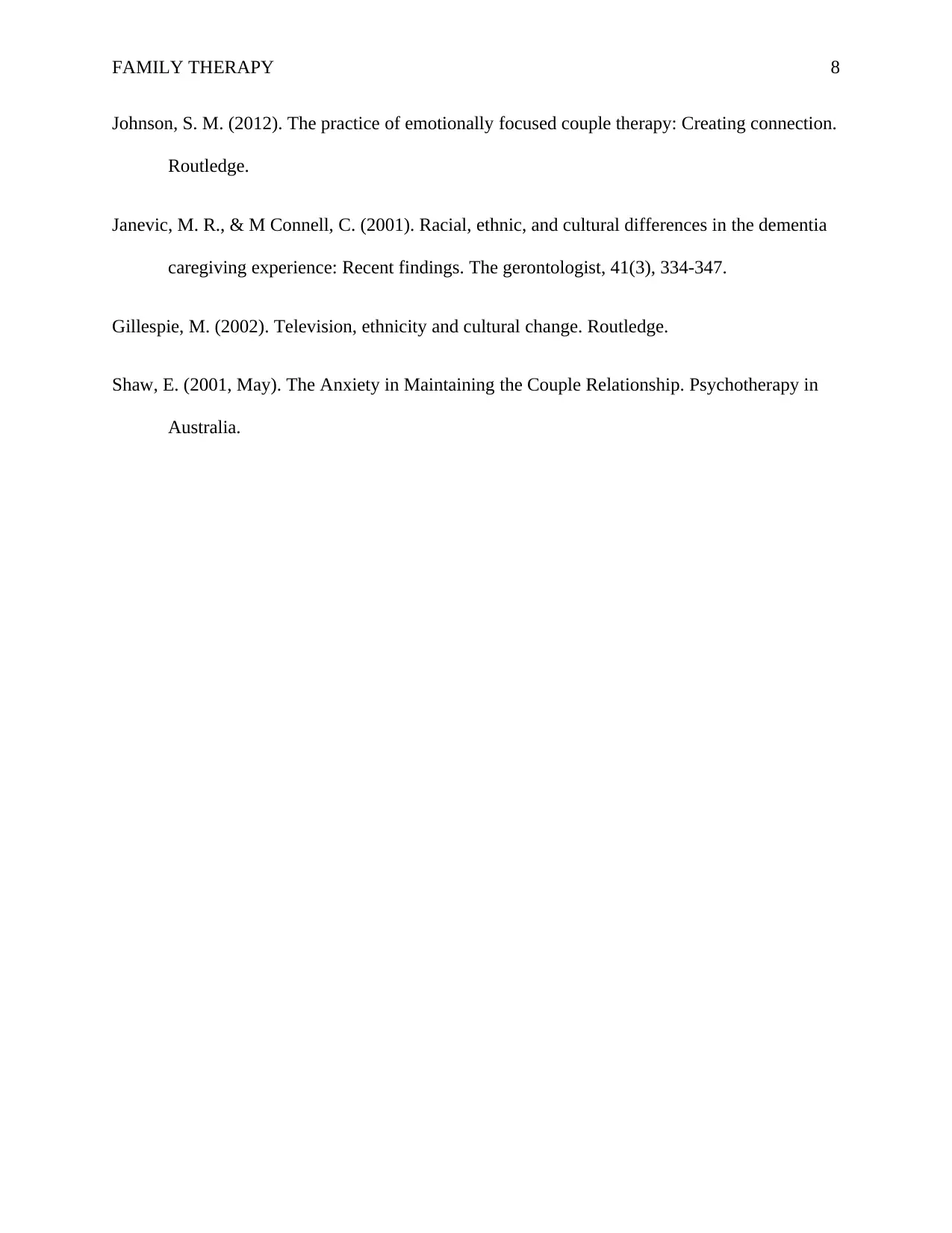
FAMILY THERAPY 8
Johnson, S. M. (2012). The practice of emotionally focused couple therapy: Creating connection.
Routledge.
Janevic, M. R., & M Connell, C. (2001). Racial, ethnic, and cultural differences in the dementia
caregiving experience: Recent findings. The gerontologist, 41(3), 334-347.
Gillespie, M. (2002). Television, ethnicity and cultural change. Routledge.
Shaw, E. (2001, May). The Anxiety in Maintaining the Couple Relationship. Psychotherapy in
Australia.
Johnson, S. M. (2012). The practice of emotionally focused couple therapy: Creating connection.
Routledge.
Janevic, M. R., & M Connell, C. (2001). Racial, ethnic, and cultural differences in the dementia
caregiving experience: Recent findings. The gerontologist, 41(3), 334-347.
Gillespie, M. (2002). Television, ethnicity and cultural change. Routledge.
Shaw, E. (2001, May). The Anxiety in Maintaining the Couple Relationship. Psychotherapy in
Australia.
1 out of 8
Related Documents
Your All-in-One AI-Powered Toolkit for Academic Success.
+13062052269
info@desklib.com
Available 24*7 on WhatsApp / Email
![[object Object]](/_next/static/media/star-bottom.7253800d.svg)
Unlock your academic potential
Copyright © 2020–2025 A2Z Services. All Rights Reserved. Developed and managed by ZUCOL.



